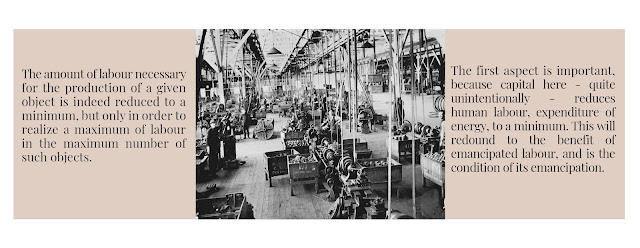(Hence the correctness of the theory of surplus population and surplus capital…) Marx mentioned, “the theory of surplus population and surplus capital,” parenthetically, in the Grundrisse and “surplus population and surplus capital” in his 1862-63 draft of Capital. Although it isn’t certain what theory exactly he was referring to, the phrase reappears, in reverse order, in chapter 15, section 3 of volume III of Capital, “Surplus Capital alongside Surplus Population,” indicating internal contradictions of the law of the tendency of the rate of profit to fall. Don’t you just hate it when your tendency has internal contradictions? It would perhaps clear up a lot of misunderstanding of Marx’s analysis that the law (of the tendency the rate of profit
Topics:
Sandwichman considers the following as important: surplus labor, surplus population, US/Global Economics
This could be interesting, too:
Joel Eissenberg writes How Tesla makes money
Angry Bear writes True pricing: effects on competition
Angry Bear writes The paradox of economic competition
Angry Bear writes USMAC Exempts Certain Items Coming out of Mexico and Canada
(Hence the correctness of the theory of surplus population and surplus capital…)

Marx mentioned, “the theory of surplus population and surplus capital,” parenthetically, in the Grundrisse and “surplus population and surplus capital” in his 1862-63 draft of Capital. Although it isn’t certain what theory exactly he was referring to, the phrase reappears, in reverse order, in chapter 15, section 3 of volume III of Capital, “Surplus Capital alongside Surplus Population,” indicating internal contradictions of the law of the tendency of the rate of profit to fall.

Don’t you just hate it when your tendency has internal contradictions? It would perhaps clear up a lot of misunderstanding of Marx’s analysis that the law (of the tendency the rate of profit to fall) resides in the rarified air of extreme abstraction. It simply sets the stage for the meat and bones of his theory, which is precisely the counteracting influences and the internal contradictions of the law, without which the whole process of capitalist production would soon collapse. Got that? Marx didn’t say capitalism would soon collapse; he tried to explain why it didn’t.
Contrary to received opinion, the tendency of the rate of profit to fall was not Marx’s invention or discovery. Much of his discussion of the tendency elsewhere in the Grundrisse is aimed at clearing up confusions about the tendency among earlier writers such as Ricardo, Carey and Bastiat (he criticized Bastiat for assuming that the fall in the rate of profit resulted from a rise in wages). In the three fragments on machines, which I am concerned with here, Marx was almost exclusively focused on the internal contradictions and counteracting influences. Case in point: the [socially necessary labour time] “required for the production of an object is indeed reduced to a minimum, but only in order to realize a maximum of labour in the maximum number of such objects.” So what is it? Reducing labour time to a minimum or realizing a maximum of labour? It’s both! That’s why it’s a contradiction.
Nobody disputes that productivity is increased by the introduction of more machines of the latest technology. Nobody disputes that those machines cost money. Nobody disputes that the cost per unit is reduced with more mechanization. The mainstream bromide is that “technology creates more jobs than it destroys.” This is no doubt true but irrelevant.
The motive for introducing those machines is to increase the proportion of surplus labour being produced for each unit of necessary labour that has to be paid for. It is a compelling motive because higher relative surplus value is needed to offset the lower profit rate resulting from a higher ratio of constant capital to variable capital, what Marx would later call the “organic composition of capital.”
It’s a vicious cycle but the bottom line is that less of the total revenue must go to labour so that more is available to fund capital investment. During the boom, a relative surplus population is already latent in those workers producing surplus capital, which cannot find profitable opportunities for productive investment and thus is diverted to speculation and “credit swindles,” and in workers producing an overflow of consumption goods for consumers who won’t have the purchasing power to buy them when the dust settles.
None of this would be any news to Maynard Keynes, Michal Kalecki, Hyman Minsky, or Kenneth Galbraith. With the possible exception of Kalecki, they thought they had a solution to the problem. So did Marx. The reduction of necessary labour time to a minimum, in spite of capital’s intention “will redound to the benefit of emancipated labour, and is the condition of its emancipation.” It is magical thinking akin to Keynes’s pseudo-Shakespearian prattling that “we must pretend to ourselves and to everyone that fair is foul and foul is fair; for foul is useful and fair is not.” Appearance may very well be deceiving but that’s no assurance that foul is fair or even useful.
To be continued…
